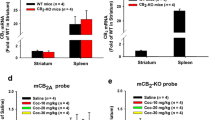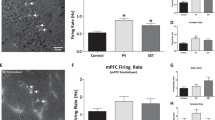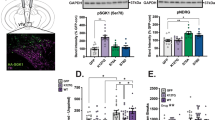Summary
1. The aim of this study was to investigate the neurochemical effects and measure the anatomical spread of infusion of c-fos antisense (AS) DNA into the striatum.
2. Rats were anesthetized and infused in opposing striata with c-fos AS and c-fos sense (S) DNA. Ten hours later they were injected with apomorphine (2 mg/kg, i.p.) and 20 min later they were overdosed with sodium pentobarbital and their brains either perfused or frozen. Vibratome-cut sections were immunostained for the detection of c-fos, JunB, Krox 24, somatostatin, substance P, dynorphin, tyrosine hydroxylase, and enkephalin. Cryostat-cut sections from the caudate were immunostained for the detection of c-fos, JunB, and Krox 24, as well asin situ hybridization for proenkephalin mRNA. Sections from the globus pallidus were used for the autoradiographic localization of D2 dopamine and A2a adenosine receptors. Sections from the substantia nigra were used for the autoradiographic localization of D1 dopamine and cannabinoid receptors. A second group of rats was injected in opposing striata with biotin-labeled c-fos AS DNA and c-fos S DNA. Ten hours later they were challenged with apomorphine (2 mg/kg, i.p.) and 20 min later brains were either perfused or frozen. Sections from these brains were cut throughout the rostral-caudal extent of the forebrain and the biotin labeled AS DNA was localized.
3. Krox 24 was expressed at high levels on the sense side of the brain in the striatum and overlying neocortex. However, on the AS-injected side there was a reduction in Krox 24 expression in striatum and overlying cortex. The biotin-labeled AS studies confirmed that the striatal infusion spread throughout the dorsal striatum as well as the overlying neocortex. We did not detect any changes in neurotransmitter receptors, neuropeptides, or tyrosine hydroxylase in AS/S-injected rat brains.
4. These results demonstrate that c-fos AS reduces Krox 24 expression in striatal and neocortical neurons but does not change the expression of a number of other proteins involved in basal ganglia function. Whether this effect is due to nonspecific actions of c-fos AS or to its effects on a component of the transduction pathway responsible for basal Krox 24 expression (NMDA receptors?) is unknown.
Similar content being viewed by others
References
Chiasson, B., Hooper, M., Murphy, P., and Robertson, H. A. (1992). Antisense oligonucleotide eliminates in vivo expression of c-fos in mammalliam brain.Eur. J. Pharmacol. 227451–452.
Cole, A. J., Bhat, R. V., Patt, C., Worley, P. F., and Baraban, J. M. (1992). D1 dopamine receptor activation of multiple transcription factor genes in rat striatum.J. Neurochem. 581420–1426.
Dilts, R. P., Helton, T. E., and McGinty, J. F. (1993). Selective induction of fos and fra immunoreactivity within the mesolimbic and mesostriatal dopamine terminal fields.Synapse 13251–263.
Dragunow, M., and Robertson, H. A. (1987). Kindling stimulation induces c-fos proteins in granule cells of the rat dentate gyrus.Nature 329441–442.
Dragunow, M., Yamada, N., Bilkey, D. K., and Lawlor, P. (1992). Induction of immediate-early gene proteins in dentate granule cells and somatostatin interneurons after hippocampal seizures.Mol. Brain Res. 13119–126.
Dragunow, M., Lawlor, P., Chiasson, B., and Robertson, H. A. (1993). c-fos antisense generates apomorphine and amphetamine-induced rotation.Neuroreport 5305–306.
Glass, M., Faull, R. L. M., and Dragunow, M. (1993). Loss of cannibinoid receptors in the substantia nigra in Hungtington's disease.Neuroscience 56523–527.
Heilig, M., Engel, J., and Soderpalm, B. (1993). C-fos antisense in the nucleus accumbens blocks the locomotor stimulant action of cocaine.Eur. J. Pharmacol. 236339–340.
MacGibbon, G., Lawlor, P. A., Bravo, R., and Dragunow, M. (1994). Clozapine and haloperidol produce a differential pattern of IEG expression in rat caudate-putamen, nucleus accumbens, lateral septum, and islands of calleja.Mol. Brain, Res. 2321–32.
Morgan, J. I., Cohen, D. R., Hempstead, J. L., and Curran, T. (1987). Mapping patterns of c-fos expression in the CNS after seizure.Science 237192–197.
Sommer, W., Bjelke, B., Gantev, and Fuxe, K. (1993). Antisense oligonucleotide to c-fos induces ipsilateral rotational behaviour to d-amphetamine.Neuroreport 5277–280.
Wahlestedt, C. (1994). Antisense oligonucleotide strategies in neuropharmacology.Trends Pharmacol. Sci. 1542–46.
Wahlestedt, C., Golanov, E., Yamamoto, S., Yee, F., Ericson, H., Yoo, H., Inturrisi, C. E., and Reis, D. J. (1993a). Antisense oligonucleotides to NMDA-R1 receptor channel protect cortical neurons from excitotoxicity and reduce focal ischaemic infarctions.Nature 363260–263.
Wahlestedt, C., Pich, E. M., Koob, G., Yee, F., and Heilig, M. (1993b). Modulation of anxiety and neuropeptide Y-Y1 receptors by antisense oligonucleotides.Science 259528–531.
Weiss, B., Zhou, L. W., Zhang, S. P., and Qin, Z. H. (1993). Antisense oligonucleotide inhibits D2-dopamine receptor-mediated behaviour and D2 mRNA.Neuroscience 55607–612.
Worley, P. F., Christy, Y., Nakabeppu, R. V., Bhat, A. J., Cole, A. J., and Baraban, J. M. (1991). Constitutive expression of zif 268 in neocortex is regulated by synaptic activity.Proc. Natl. Acad Sci. USA 885106–5109.
Zhang, M., and Creese, I. (1993). Antisense oligonucleotide reduces brain dopamine D2 receptors: Behavioural correlates.Neurosci. Lett. 161223–226.
Author information
Authors and Affiliations
Rights and permissions
About this article
Cite this article
Dragunow, M., Tse, C., Glass, M. et al. c-fos antisense reduces expression of Krox 24 in rat caudate and neocortex. Cell Mol Neurobiol 14, 395–405 (1994). https://doi.org/10.1007/BF02088826
Received:
Issue Date:
DOI: https://doi.org/10.1007/BF02088826




